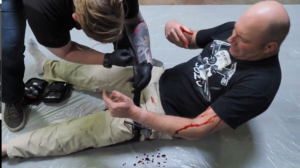2 Reasons Why You Should NEVER Remove A Tourniquet

There are many medical myths in the world. Most of the old ones have been phased out of western medicine with the advent of scientific research, but some still persist.
In some places of the world, smearing canine feces on an open wound is thought to promote healing. Which, of course, is absolutely not the case. Time and again I hear a particular rumor from the general population and it’s dying a slow death. While some rumors are harmless or mildly inconvenient, this one has the potential to get people killed.

The Wind River Trauma Kit is one of our top sellers.
Myth
“You should remove or loosen the tourniquet so blood flow can return to the limb and then it won’t have to be amputated.”
False!
- After you have correctly applied a tourniquet, it should remain in place until a doctor can be prepared to control bleeding and handle many other potential complications.
If the victim you have applied a TQ to is awake, and the tourniquet has been applied correctly, the victim will probably try to talk you into taking it off or loosening it because of how uncomfortable it is.
It’s completely normal for a TQ to by painful. The only way around that pain without killing our casualties, is to get them to the hospital as quickly as possible where high potency medications can be administered, and the injuries addressed.
By loosening the TQ to make it more comfortable, will only let your casualty bleed out, even if more slowly. And there’s a good chance that with the loss of so much blood, they may need every little bit they can keep in. The loss of any more blood could mean death.
- The build of toxins the tourniqueted limb.
When a TQ is applied it shuts down blood flow and controls bleeding by not allowing any blood to flow to and from the wound. This is great for keeping the casualty alive, but in applying a TQ the blood is no longer removing wastes and toxins from the body’s tissue. These toxins build up over time and if the TQ is released, these toxins flood into the blood stream and flow right into the kidneys and other body filters, shutting them down.
This is why it is so important to leave a tourniquet in place after it’s been applied. No TQ should be removed without a doctor present to oversee the recovery, or we could end up killing the casualty you have been working so hard to save.
And don't forget! As long as we get the casualty to the ER within 2 hours of application, there will be very little risk of losing the limb because of the TQ.
If you would like to learn more life saving skills, Check out the 100% free Emergency Trauma Response Course.

So how do you deal with trauma incident where medical help is hours or days away (think marine or sailing offshore)? If the bleeding is so severe as to require a tourniquet, are we face with a field expedient amputation? I shudder to imagine what that would be like.
Loosing a limb is better than loosing a life